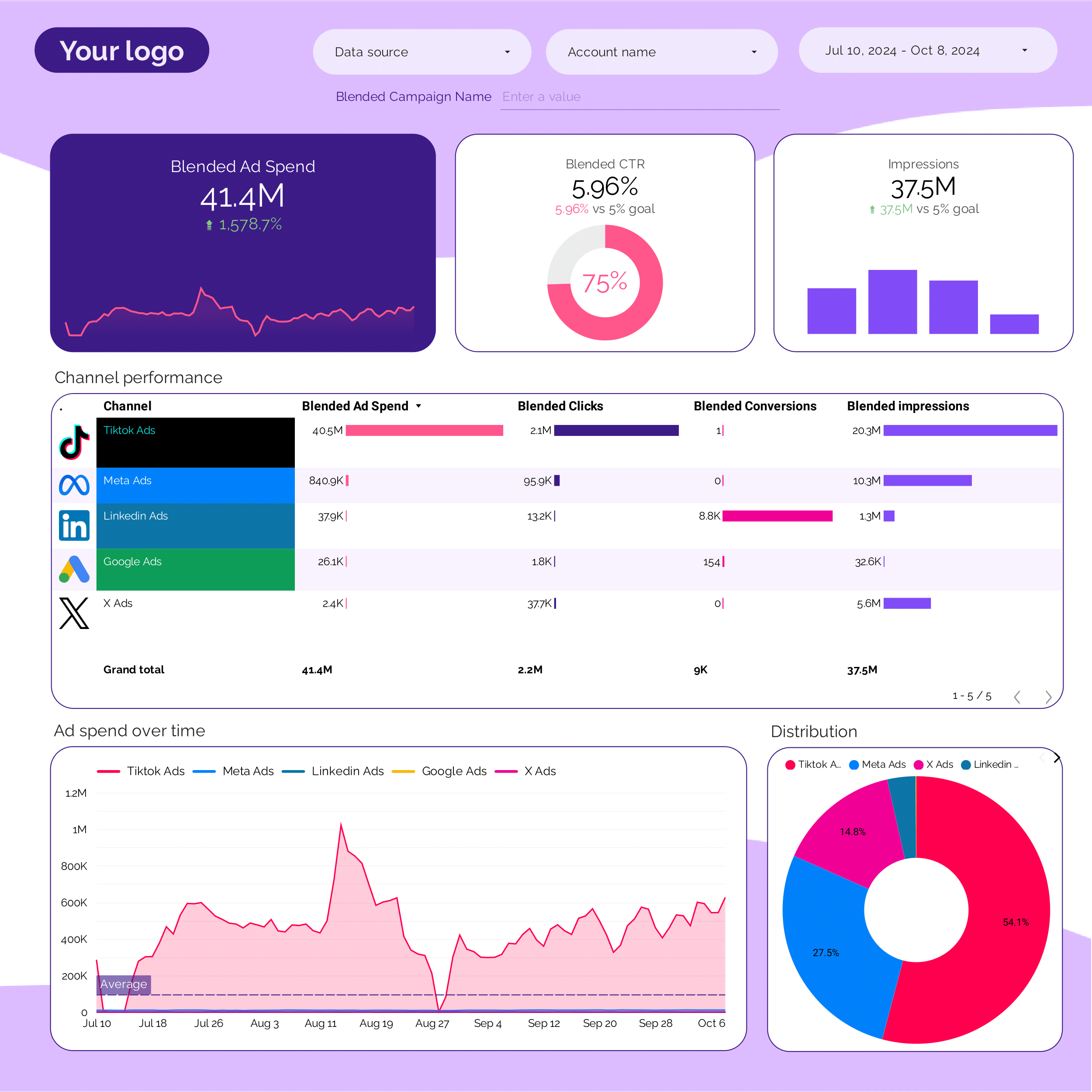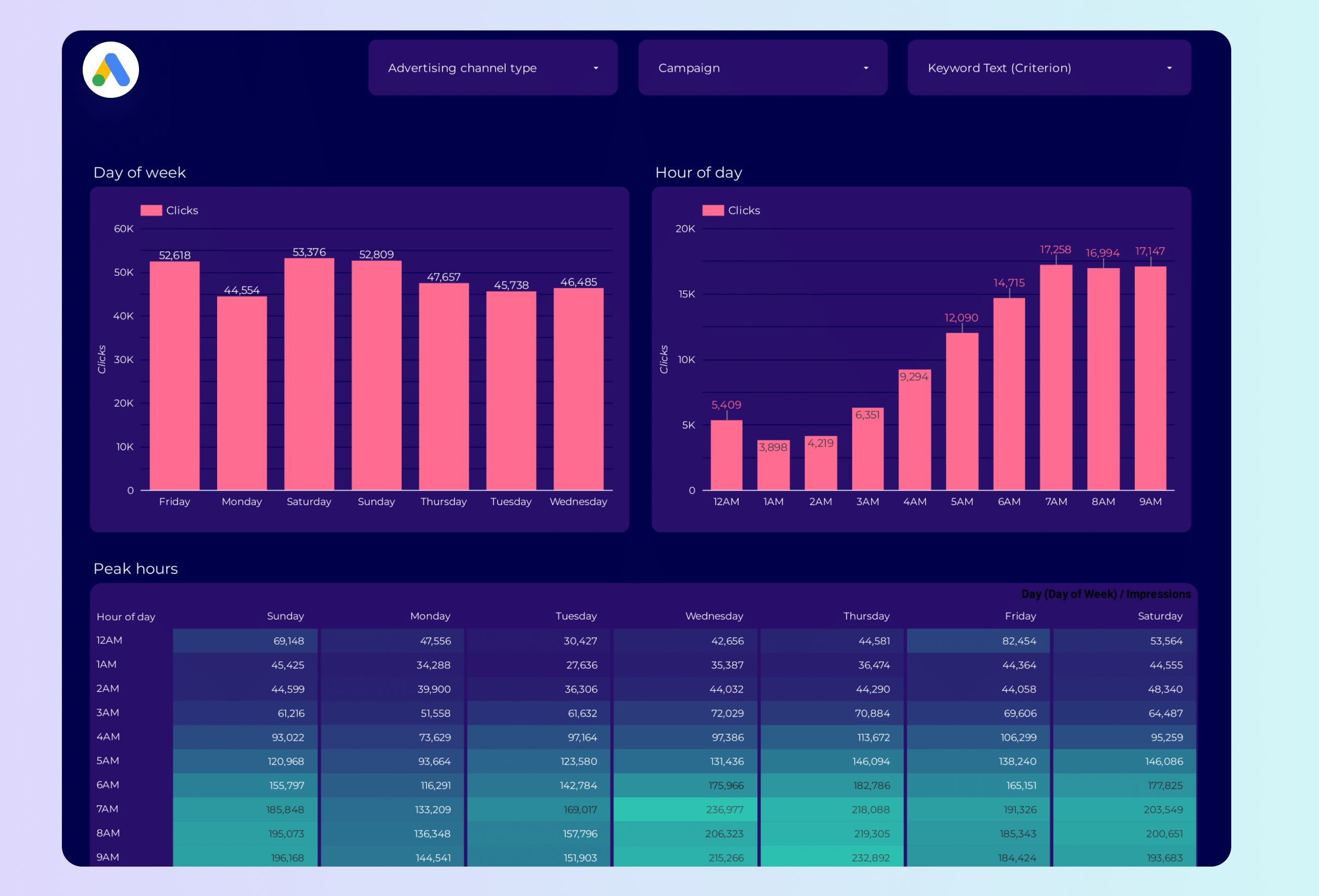
B2B Marketing performance Report template for Marketing teams and agencies
Optimize B2B Marketing performance with this report template. Track metrics like conversion rate, cost per acquisition, and customer lifetime value. Analyze CRM contacts and segment by industry, company size, and location. Ideal for marketing teams to measure and strategize using B2B, CRM, and Email Marketing data sources.

Google Ads Audience Report template for Marketing teams and agencies
Analyze key metrics such as conversion rate, CTR, and engagement with this Google Ads Audience report template. Track audience segments and campaign types over various timeframes. Designed for PPC specialists to measure performance and refine strategies using data from Google Ads and Paid Media.

Paid media Creative performance Report template for Marketing teams and agencies
Analyze key metrics with the Paid media Creative performance report template. Measure CTR, CPA, and conversion rates across Facebook, TikTok, and Google Ads. Segment by audience, message, and channel. Track impressions, reach, and engagement. Ideal for marketing teams to refine PPC strategies and meet specific goals.

Social Media Post performance Report template for Marketing teams and agencies
Optimize your strategy with the Social Media Post performance report template. Track key metrics like conversion rate, ROI, and CTR. Segment by audience, platform, or campaign objective. Utilize data from Social Media and Instagram Insights. Ideal for marketing teams to enhance engagement and reach.

Brand awareness Report template for Marketing teams and agencies
Awareness report template consolidates key metrics like CTR, CPA, and conversion rate from Social Media, Instagram Insights, and LinkedIn Pages. Analyze demographics, psychographics, and behavior over time. Perfect for marketing teams to track performance and strategy, providing actionable insights into audience engagement and organic search ranking.

Google Ads Campaign performance Report template for Marketing teams and agencies
Analyze key metrics like conversion rate, CTR, and impressions with this Google Ads Campaign performance report template. Segment by campaign type, audience, and time. Ideal for PPC specialists to track performance and refine paid media strategies. Consolidate data from Google Ads for actionable insights and strategic marketing goals.

PPC Report template for Marketing teams and agencies
Optimize your PPC strategy with this report template. Track metrics like conversion rate, ROAS, and CTR across Facebook Ads, TikTok Ads, and Google Ads. Analyze by audience, channel, and time. Ideal for marketing teams to measure campaign performance and achieve objectives efficiently.

TikTok Ads Report template for Marketing teams and agencies
Optimize TikTok Ads performance with this report template. Track CTR, conversion rate, and cost per conversion. Analyze impressions, reach, and engagement. Segment by audience, ad placement, and time. Perfect for PPC specialists aiming to achieve marketing goals and enhance strategy.

Community manager Report template for Marketing teams and agencies
Community manager Social Media report template tracks key metrics like conversion rate, cost per conversion, and engagement. Analyze dimensions such as campaign duration, budget, and audience demographics. Monitor likes, shares, and comments across Social Media platforms. Ideal for community managers to consolidate data and refine social media strategy.

Google Ads Funnel Report template for Marketing teams and agencies
Track key metrics like conversion rate and CTR with the Google Ads Funnel report template. Analyze performance across campaigns, ad groups, and devices. Segment by time and audience type. Perfect for PPC specialists and marketers using Google and Facebook Ads to optimize paid media strategies and achieve specific marketing objectives.
PPC budget tracking and pacing Report template for Marketing teams and agencies
Get the actual PPC budget tracking and pacing on Looker Studio template used by Porter to monitor PPC performance.

Twitter Ads Report template for Marketing teams and agencies
Analyze key metrics like CTR, conversion rate, and social actions with this Twitter Ads report template. Track performance by campaign objective, ad format, and audience targeting. Segment data by time, location, gender, and age. Perfect for PPC specialists to consolidate Twitter Ads and Paid Media strategies for actionable insights.

Creator marketing Report template for Marketing teams and agencies
Track key metrics like CTR, conversion rate, and ROAS with the Creator marketing report template. Analyze audience breakdowns by demographics, psychographics, and behavior. Measure engagement through likes, shares, and comments. Utilize data from Social Media, Instagram Insights, and LinkedIn Pages. Optimize strategy with actionable insights segmented by time periods. Ideal for marketing teams.

Google Ads Keyword analysis Report template for Marketing teams and agencies
Track key metrics like conversion rate, CTR, and impressions with the Google Ads Keyword analysis report template. Analyze performance by campaign type, device, and more. Consolidate data from Google Ads and Keywords. Ideal for PPC specialists to optimize strategy and meet marketing objectives. Segment by time for specific insights.

PPC Campaign performance Report template for Marketing teams and agencies
Get the actual PPC Campaign performance on Looker Studio template used by Porter to monitor PPC performance.

Youtube Report template for Marketing teams and agencies
Optimize your social media strategy with this Youtube report template. Track CTR, conversion rate, CPA, likes, comments, shares, views, watch time, and subscribers. Analyze by audience, age, gender, interests, and time. Perfect for marketing teams seeking actionable insights to enhance performance across advertising platforms and align with SEO objectives.

CRM Report template for Marketing teams and agencies
CRM report template tracks key metrics: conversion rate, cost per acquisition, ROI. Analyze demographic, geographic, and psychographic data. Measure sales cycle length, average deal size, and CRM contact conversion. Ideal for B2B and email marketing teams to consolidate insights and refine strategies.

Google Ads Peak hours Report template for Marketing teams and agencies
Optimize your PPC strategy with the Google Ads Peak hours report template. Track key metrics like conversion rate, CPC, and CTR. Analyze performance by campaign type, device, and time. Measure impressions and audience size during peak hours. Ideal for marketing teams to consolidate insights and achieve specific goals.

Demand generation Report template for Marketing teams and agencies
Optimize B2B demand generation with this report template. Track conversion rates, cost per conversion, and click-through rates. Analyze social media shares and impressions. Integrate data from CRM, E-commerce, Facebook Ads, Google Analytics 4, and LinkedIn Ads. Segment by demographics and time for strategic insights. Ideal for marketing teams focused on performance.

Google Ads PMax Report template for Marketing teams and agencies
Track key metrics with this Google Ads PMax report template. Measure conversion value, CTR, and impressions. Analyze by campaign type, audience segment, and time period. Consolidate data from Google Ads and Paid Media for actionable insights. Ideal for marketing teams focused on optimizing PPC performance and achieving strategic goals.

